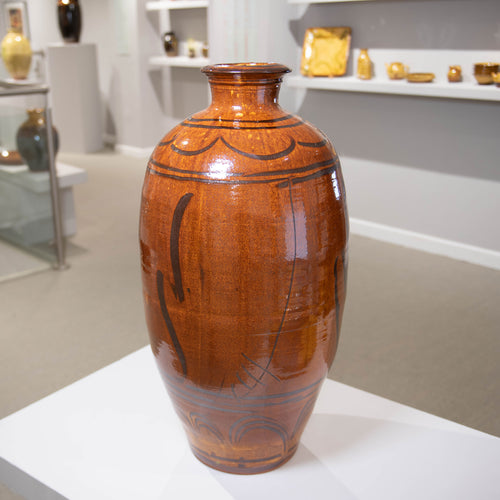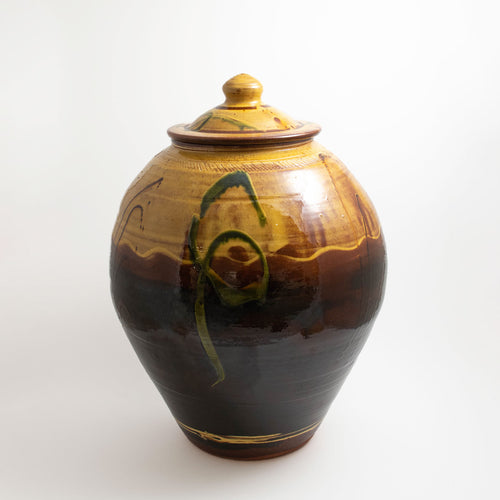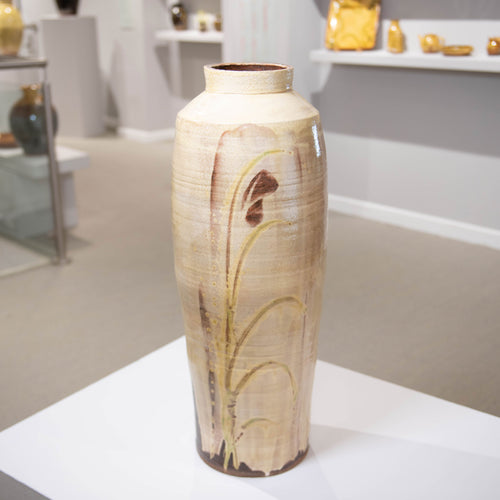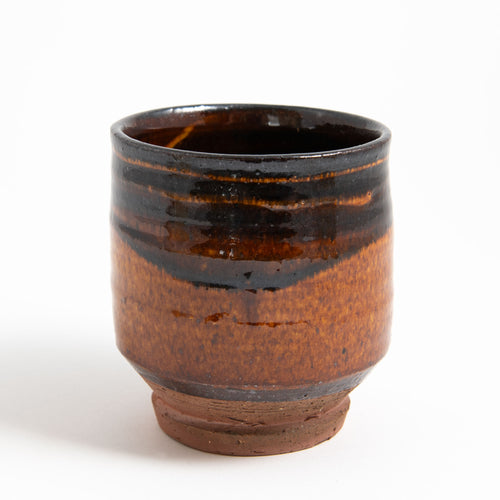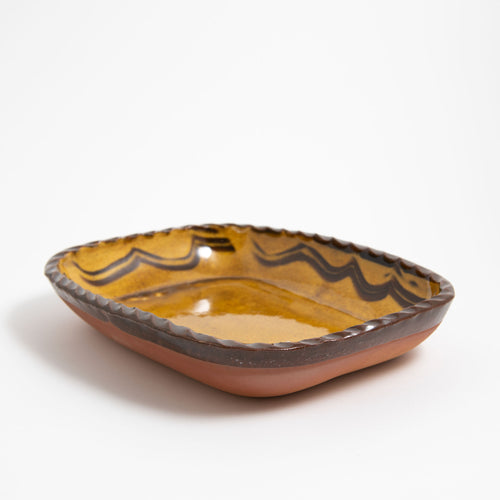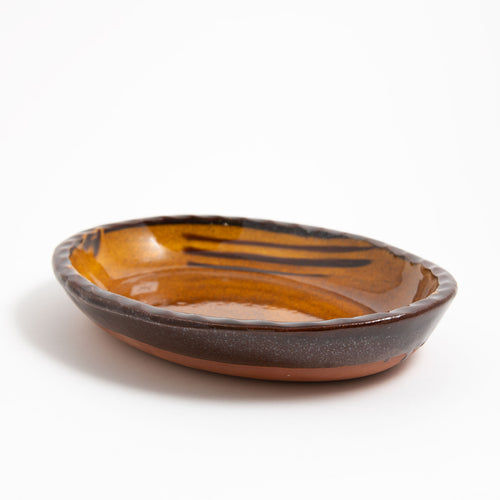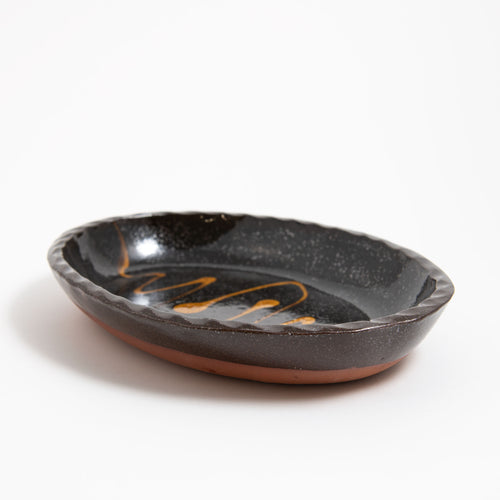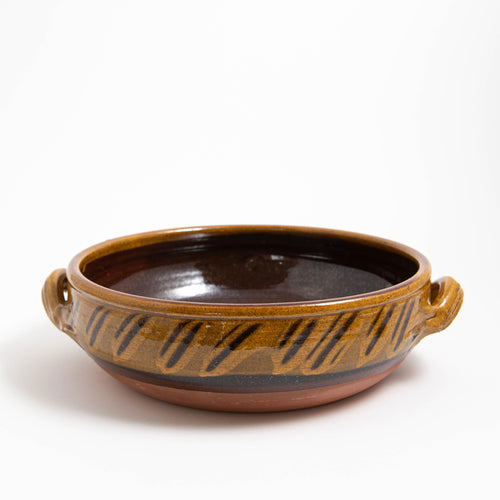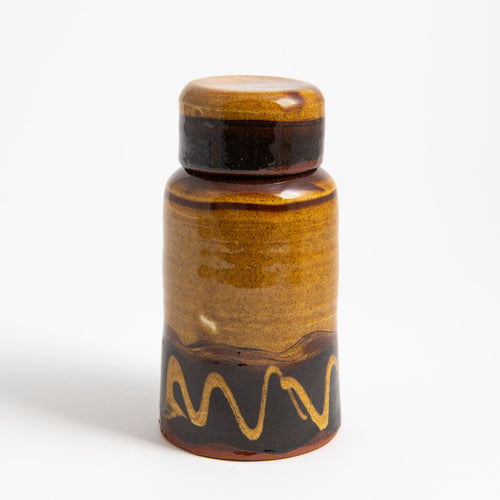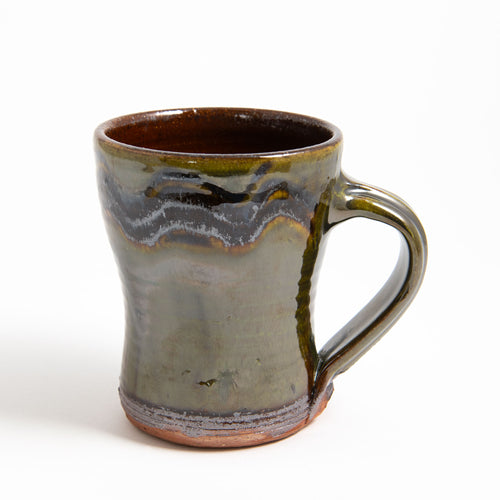Two weeks ago we posted the first article in our 'How to Spot a Good Pot' series looking at the importance of form.
This week in part 2 we turn to the surface of a pot - decorative marks and gestures, the effects of different firings on applied glazes and raw clay, and, most importantly, the cohesion between a pot's surface and its underlying form.
 large square dish exhibiting free and loose decoration from Clive Bowen
large square dish exhibiting free and loose decoration from Clive Bowen
Surface decoration, whether applied by the hand of the potter or achieved through the atmosphere of the kiln, can make or break a pot. If form and silhouette is what we first see in a pot, the quality of the surface is what makes us keep looking, makes us want to pick up and touch it and to pass it through our hands or walk around it to read the story in its outer layer.
 French potter Jean-Nicolas Gérard's beakers, each showing the dimple of its maker's thumb and the ripple effect from their throwing on the wheel
French potter Jean-Nicolas Gérard's beakers, each showing the dimple of its maker's thumb and the ripple effect from their throwing on the wheel
Working the surface of a pot can begin as early as when it is first thrown on the wheel. Subtle marks such as the ripple of throwing rings where a pot wall has been pulled up or the telltale signs of a potter's impressed fingers and thumbs in the clay can contribute as much to the character of a pot and its final appearance as more obvious choices in how the surface is presented.
 (above) Mike Dodd prepares a textured vase on his wheel, ready for opening out; (below) the finished result, a combination of decorative innovation and beautiful glaze surfaces
(above) Mike Dodd prepares a textured vase on his wheel, ready for opening out; (below) the finished result, a combination of decorative innovation and beautiful glaze surfaces

As a vessel is being thrown, the potter is presented with two such choices - to decorate the pot in part by hand, or to limit the decoration of its surface solely to the kiln. Many factors can influence which decision will be made: whether the form lends itself naturally to mark-making; what glazes will be applied and what kind of firing it will undergo; and, of course, each potter's personal aesthetic.
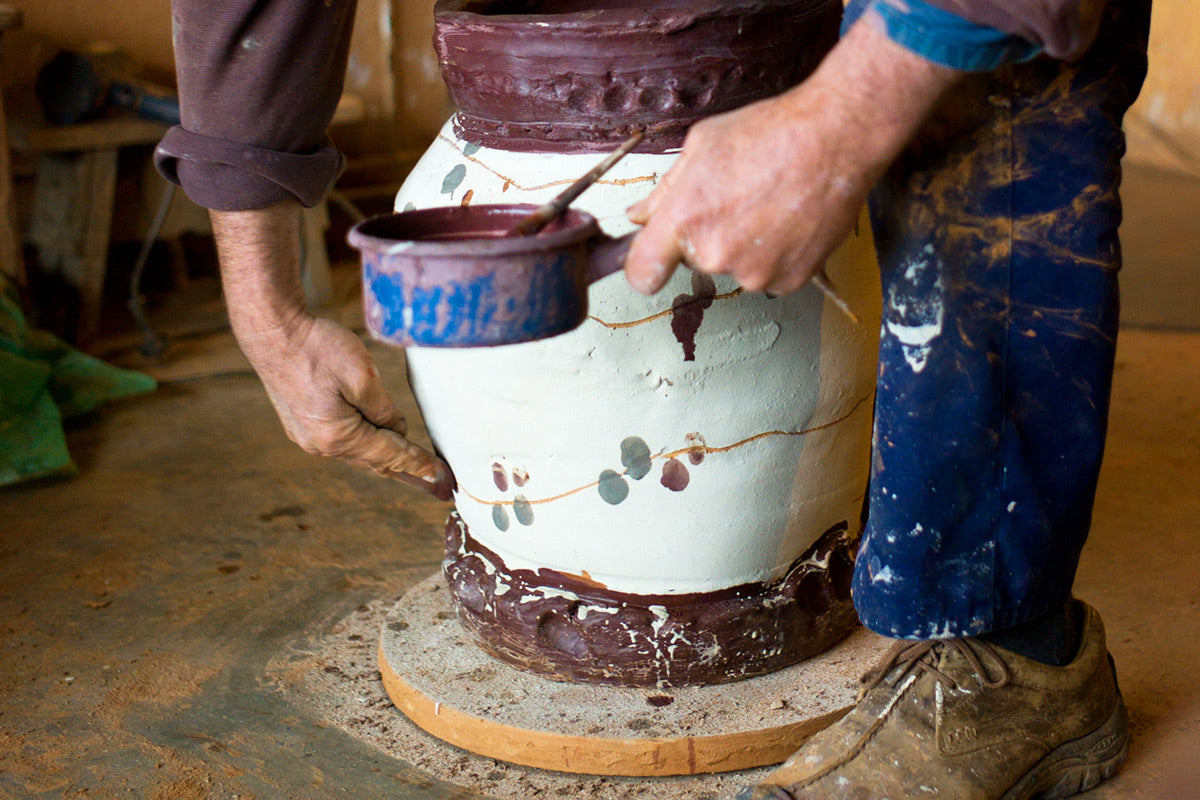
 Jean-Nicolas Gérard and his spontaneous fingerprint and sgraffito decoration on a large vase
Jean-Nicolas Gérard and his spontaneous fingerprint and sgraffito decoration on a large vase
Often a potter may choose how to decorate their work instinctively as the piece emerges on the wheel; at other times the pot may be planned in advance, its maker working to a sketch or an image of the final result in their head. Invariably, successful surface decoration will involve a little of both - of working with a clear initial idea, but adapting to changes in the pot as it comes to fruition.
 wood-fired teapot by Svend Bayer, the surface colour and texture entirely the result of ash and flames in the kiln
wood-fired teapot by Svend Bayer, the surface colour and texture entirely the result of ash and flames in the kiln
Some potters, especially wood-firers, leave the decoration of their pots to the firing, trusting in the kiln to produce the desired effects on their pot surfaces. Though it may sound less involved than the gestural work of mark-making and brushwork, quite the opposite is true.
Decoration for the wood-firer is as much intellectual as physical; it involves thinking carefully when packing the kiln about the path of the fire around the stacked pots, about the different atmospheric 'zones' within the kiln and the influence of constant temperature and pressure changes on the movement of the flames.
 plates by Danish potter Anne Mette Hjortshøj; stacked on top of one another, fly ash can only reach the edges of each plate, leaving the centre relatively clear and providing a natural contrast
plates by Danish potter Anne Mette Hjortshøj; stacked on top of one another, fly ash can only reach the edges of each plate, leaving the centre relatively clear and providing a natural contrast
Pots must also be placed with consideration as to where ash will land on the clay surfaces and which areas of the pots will remain shielded from the flying embers, as well as how the glaze produced from the ash will pool around the pot. Many wood-firing potters will place round pots such as bottles and jars on their sides for exactly this reason: if left upright, ash glaze could run down and gather at the bottom of the pot, leaving the dramatic colours and textures achieved out of sight; turned on their sides, these pools will work their way around the pot instead, forming beautiful glass-like beads or trails.
 a small bottle Nic Collins has sat on its side in the Anagama kiln on top of a sea-shell; the small bead of glaze on its rim and the heavily ashed side tell the story of its firing
a small bottle Nic Collins has sat on its side in the Anagama kiln on top of a sea-shell; the small bead of glaze on its rim and the heavily ashed side tell the story of its firing
Good wood-fired pots will naturally tell the story of their firing through their surfaces. They will often have obvious 'faces', where the clay has met with strong flames, embers and ash from a stoking hole, or where it has been sheltered from the fierce elements by a nest of other pots. Well thought through firings will produce pots that have been submitted to effects in the kiln that suit their form, that exhibit natural contrasts and varied surfaces and that collectively represent the special qualities of that potter's kiln and process.
 plates by Jean-Nicolas Gérard with rapid, freehand sgraffito lines and thumbprints that remain as lively and dynamic as when first applied to the pot
plates by Jean-Nicolas Gérard with rapid, freehand sgraffito lines and thumbprints that remain as lively and dynamic as when first applied to the pot
Process should always be evident in good pot decoration, whether the scorched blushes and crusty colours of firing effects or the lines and motifs of handiwork. Handmade marks that are overly contrived or fussy can ruin the feel of a well-thrown pot. Applied decoration can still be precise, fine and delicate - but above all it should be rhythmic, in tune with the shape and planes of the pot and exhibiting the same liveliness that was shown by the potter in its making.
 chawan by Phil Rogers; slight undulations in the central ridge lend this piece a subtle but crucial sense of rhythm and movement, counterbalanced by alternating embossed stamps
chawan by Phil Rogers; slight undulations in the central ridge lend this piece a subtle but crucial sense of rhythm and movement, counterbalanced by alternating embossed stamps
Decoration by hand is more difficult than it would appear - for any potter, but especially for the slipware makers whose oeuvre depends so heavily on decorative work. Too much, and the pots appear overworked and busy. Too little, and whatever embellishments have been made become lost, and are either so isolated as to be unnoticed or so focal as to seem divorced from the underlying form. Decoration is, by its nature, 'superficial'; to imbue it with depth is a tricky thing.
 Clive Bowen slip-trailing onto a large dish; the slip dries quickly, and must be moved at speed and with confidence
Clive Bowen slip-trailing onto a large dish; the slip dries quickly, and must be moved at speed and with confidence
The difficulty is compounded when working with slips or applied glazes. The liquid clay mixtures 'stiffen' upon contact with the drier surface as water is sucked from the slip into the clay pot. Decoration in wet glaze such as combing or finger-swiping must be performed quickly in a balancing act between speed, accuracy and composition that can challenge even a seasoned potter. With less successful results there is a ‘disconnect’ between the decorative surface and the form beneath.
 (above) Bowen again applying slip, this time to a jug and with a pipette, his lines echoing the curve of the form beneath; (below) a Clive Bowen teapot with characteristic slip sweeps
(above) Bowen again applying slip, this time to a jug and with a pipette, his lines echoing the curve of the form beneath; (below) a Clive Bowen teapot with characteristic slip sweeps

As with work decorated by the kiln, good hand-decorated pots should have a sense of narrative. The slip-lines and sgraffito carvings of a bowl or jar, when followed with a finger, should guide your hands around the form so that you feel the whole pot intimately. Marks and lines should be produced with an animation and freedom about them, as if they had a life that was instilled by the potter at the moment of creation.
 (above) Anne Mette Hjortshøj's handmade stamps and pressed handles allow glaze to gather and offer contrast; (below) Anne Mette stamps the bottom of her dishes too, an area often neglected when it comes to surface decoration
(above) Anne Mette Hjortshøj's handmade stamps and pressed handles allow glaze to gather and offer contrast; (below) Anne Mette stamps the bottom of her dishes too, an area often neglected when it comes to surface decoration

Other changes to the surface of a pot, through impressed stamps, paddles, faceted sides and incised shapes, can provide visual and tactile interest in variations of colour and texture. Embossed designs pick up pools of glaze to make an otherwise monotone pot stand out. Cut lines and painted motifs can accentuate the form beneath, marrying the inner three-dimensional structure of a pot to its two-dimensional exterior.
 (above) a Phil Rogers chawan with incised decoration that recalls the surroundings of his rural Mid-Wales pottery; (below) a square bottle by Anne Mette Hjortshøj works almost as a canvas to reflect the local Bornholm landscape
(above) a Phil Rogers chawan with incised decoration that recalls the surroundings of his rural Mid-Wales pottery; (below) a square bottle by Anne Mette Hjortshøj works almost as a canvas to reflect the local Bornholm landscape

If the surface of a pot tells a story, decoration is the potter's language, gestural marks and impressed shapes their vocabulary. Like the best storytellers, the work of good potters will speak to us with a unique voice, a particular combination of words and phrasing - of marks and kiln effects - that could only be that maker's.
 large vase by Jean-Nicolas Gérard; Gérard's golden yellow slip, sgraffito lines and fingerprint painting echoes the rows of grapevines and lavender fields in the hills of Provence
large vase by Jean-Nicolas Gérard; Gérard's golden yellow slip, sgraffito lines and fingerprint painting echoes the rows of grapevines and lavender fields in the hills of Provence
Ultimately, the surface of a pot is an area for self-expression. The best pots will have glaze surfaces, decorative marks and signs of their firing that capture and distill the essence of their maker, that reflect their place of work, their working methods, and even their principles and philosophies. Together with form, good surface is what provides a pot with character - both its own and its creator's.

